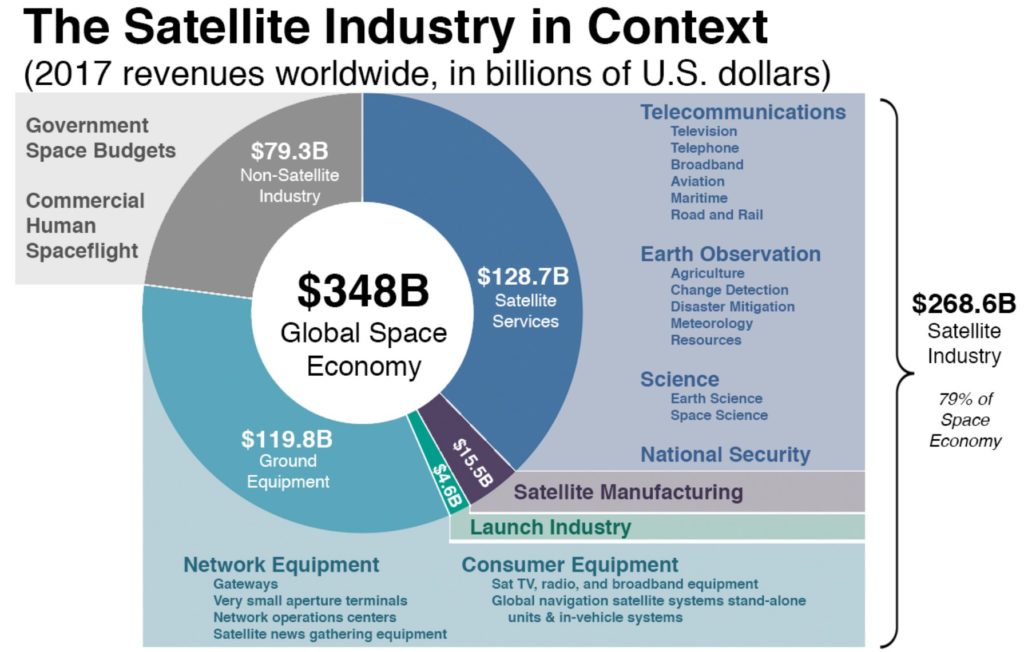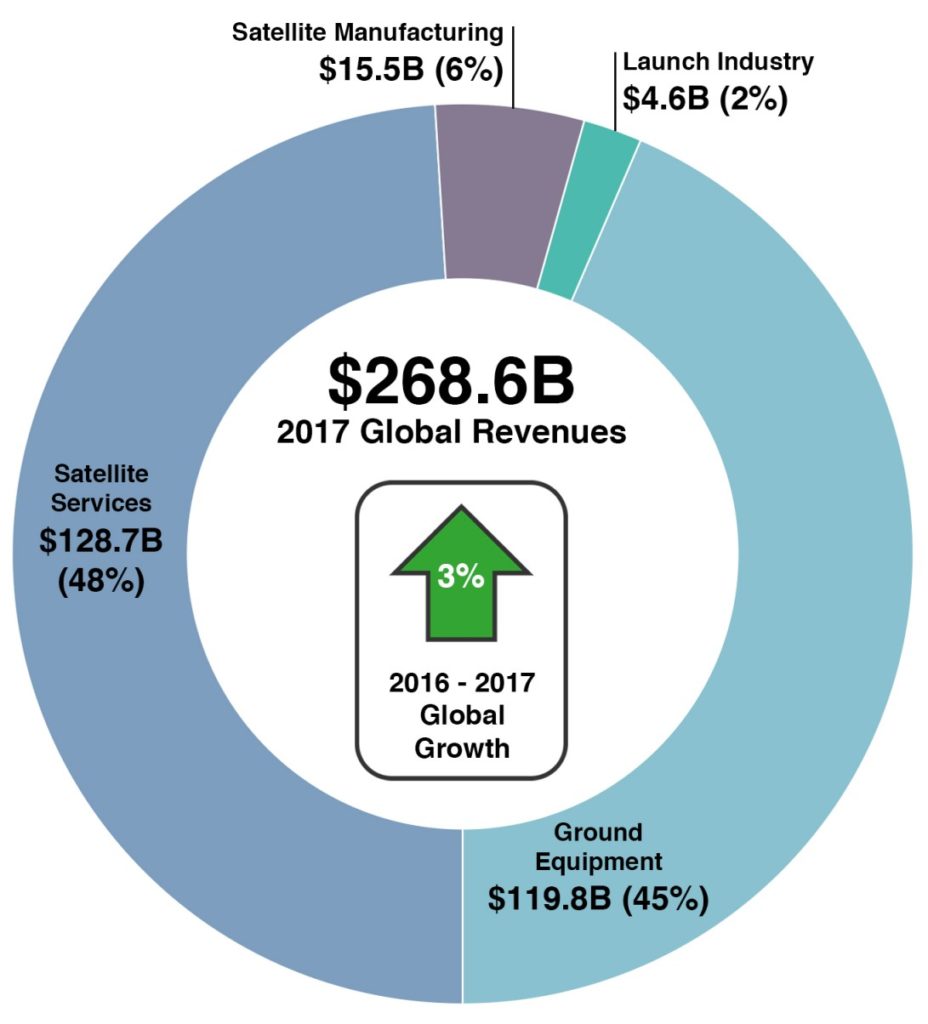

News
SpaceX’s ultimate ace in the hole is its Starlink satellite internet business
In a 2018 report on the current state of the satellite industry, the rationale behind SpaceX’s decision to expand its business into the construction and operation of a large satellite network – known as Starlink – was brought into sharp contrast, demonstrating just how tiny the market for orbital launches is compared with the markets those same launches create.
First and foremost, it must be acknowledged that SpaceX’s incredible strides in launch vehicles over the last decade or so have been explicitly focused on lowering the cost of access to orbit, the consequences of which basic economics suggests should be a subsequent growth in demand for orbital access. If a sought-after good is somehow sold for less, one would expect that more people would be able and willing to buy it. The launch market is similar, but also very different in the sense that simply reaching orbit has almost no inherent value on its own – what makes it valuable are the payloads, satellites, spacecraft, and humans that are delivered there.
- An overview of space industry in 2017, produced by Bryce Space & Technology for the 2018 State of Satellite Industry Report.
- SpaceX’s first two Starlink prototype satellites are pictured here before their inaugural Feb. 2018 launch, showing off a utilitarian design. (SpaceX)
As a consequence, if the cost of access to orbit plummets (as SpaceX hopes to do with reusability) but the cost of the cargo still being placed there does not, there would essentially be no reason at all for demand for launches to increase. For there to be more demand for cheaper launches, the cost of the satellites that predominately fuel the launch market also needs to decrease.

One of the first two prototype Starlink satellites separates from Falcon 9’s upper stage, March 2018. (SpaceX)
Enter Starlink, SpaceX’s internal effort to develop – nearly from scratch – its own highly reliable, cheap, and mass-producible satellite bus, as well as the vast majority of all the hardware and software required to build and operate a vast, orbiting broadband network. Add in comparable companies like OneWeb and an exploding landscape of companies focused on creating a new generation of miniaturized satellites, and the stage has truly begun to be set for a future where the cost of orbital payloads themselves wind up dropping just as dramatically as the cost of launching them.
Just by sheer numbers alone, stepping from launch vehicle and spacecraft production and operations into the satellite manufacturing, services, and connectivity industries is a no-brainer. Bluntly speaking, the market for rocket launches makes up barely more than one-sixtieth – less than 2% – of the entire commercial satellite industry, while services (telecommunications, Earth observation, science, etc.) and equipment (user terminals, GPS receivers, antennae, etc) account for more than 93%. Even the satellite manufacturing industry taken on its own is more than three times as large as the launch industry – $15.5b versus $4.6b in 2017.
In other words, even if SpaceX was to drop the cost of Falcon 9, Heavy, and BFR launches by a factor of 10 and the market for launches expanded exponentially as a result (say 50-100x), the market for launches would still be a tiny fraction of the stagnant, unchanged, unimproved satellite services and production industries. Put simply, there is scarcely any money to be made in rocket launches when compared with literally any other space-related industry.
- An overview of just the commercial aspects of the satellite industry. (SIA)
- Falcon Heavy’s inaugural launch, February 2018. (Tom Cross)
While far from a done deal, Starlink is thus without a doubt the most promising established method for SpaceX to dramatically increase its profitable income, income which could thus be invested directly in launch vehicles, space resource utilization, sustainable interplanetary colonies, and more, all while potentially revolutionizing global freedom of connectivity.

News
Tesla (TSLA) receives “Buy” rating and $551 PT from Canaccord Genuity
He also maintained a “Buy” rating for TSLA stock over the company’s improving long-term outlook, which is driven by autonomy and robotics.

Canaccord Genuity analyst George Gianarikas raised his Tesla (NASDAQ:TSLA) price target from $482 to $551. He also maintained a “Buy” rating for TSLA stock over the company’s improving long-term outlook, which is driven by autonomy and robotics.
The analyst’s updated note
Gianarikas lowered his 4Q25 delivery estimates but pointed to several positive factors in the Tesla story. He noted that EV adoption in emerging markets is gaining pace, and progress in FSD and the Robotaxi rollout in 2026 represent major upside drivers. Further progress in the Optimus program next year could also add more momentum for the electric vehicle maker.
“Overall, yes, 4Q25 delivery expectations are being revised lower. However, the reset in the US EV market is laying the groundwork for a more durable and attractive long-term demand environment.
“At the same time, EV penetration in emerging markets is accelerating, reinforcing Tesla’s potential multi‑year growth runway beyond the US. Global progress in FSD and the anticipated rollout of a larger robotaxi fleet in 2026 are increasingly important components of the Tesla equity story and could provide sentiment tailwinds,” the analyst wrote.
Tesla’s busy 2026
The upcoming year would be a busy one for Tesla, considering the company’s plans and targets. The autonomous two-seat Cybercab has been confirmed to start production sometime in Q2 2026, as per Elon Musk during the 2025 Annual Shareholder Meeting.
Apart from this, Tesla is also expected to unveil the next-generation Roadster on April 1, 2026. Tesla is also expected to start high-volume production of the Tesla Semi in Nevada next year.
Apart from vehicle launches, Tesla has expressed its intentions to significantly ramp the rollout of FSD to several regions worldwide, such as Europe. Plans are also underway to launch more Robotaxi networks in several more key areas across the United States.
News
Waymo sues Santa Monica over order to halt overnight charging sessions
In its complaint, Waymo argued that its self-driving cars’ operations do not constitute a public nuisance, and compliance with the city’s order would cause the company irreparable harm.

Waymo has filed a lawsuit against the City of Santa Monica in Los Angeles County Superior Court, seeking to block an order that requires the company to cease overnight charging at two facilities.
In its complaint, Waymo argued that its self-driving cars’ operations do not constitute a public nuisance, and compliance with the city’s order would cause the company irreparable harm.
Nuisance claims
As noted in a report from the Los Angeles Times, Waymo’s two charging sites at Euclid Street and Broadway have operated for about a year, supporting the company’s growing fleet with round-the-clock activity. Unfortunately, this has also resulted in residents in the area reportedly being unable to sleep due to incessant beeping from self-driving taxis that are moving in and out of the charging stations around the clock.
Frustrated residents have protested against the Waymos by blocking the vehicles’ paths, placing cones, and “stacking” cars to create backups. This has also resulted in multiple calls to the police.
Last month, the city issued an order to Waymo and its charging partner, Voltera, to cease overnight operations at the charging locations, stating that the self-driving vehicles’ activities at night were a public nuisance. A December 15 meeting yielded no agreement on mitigations like software rerouting. Waymo proposed changes, but the city reportedly insisted that nothing would satisfy the irate residents.
“We are disappointed that the City has chosen an adversarial path over a collaborative one. The City’s position has been to insist that no actions taken or proposed by Waymo would satisfy the complaining neighbors and therefore must be deemed insufficient,” a Waymo spokesperson stated.
Waymo pushes back
In its legal complaint, Waymo stated that its “activities at the Broadway Facilities do not constitute a public nuisance.” The company also noted that it “faces imminent and irreparable harm to its operations, employees, and customers” from the city’s order. The suit also stated that the city was fully aware that the Voltera charging sites would be operating around the clock to support Waymo’s self-driving taxis.
The company highlighted over one million trips in Santa Monica since launch, with more than 50,000 rides starting or ending there in November alone. Waymo also criticized the city for adopting a contentious strategy against businesses.
“The City of Santa Monica’s recent actions are inconsistent with its stated goal of attracting investment. At a time when the City faces a serious fiscal crisis, officials are choosing to obstruct properly permitted investment rather than fostering a ‘ready for business’ environment,” Waymo stated.
News
Tesla FSD v14.2.2 is getting rave reviews from drivers
So far, early testers have reported buttery-smooth drives with confident performance, even at night or on twisty roads.

Tesla Full Self-Driving (Supervised) v14.2.2 is receiving positive reviews from owners, with several drivers praising the build’s lack of hesitation during lane changes and its smoother decision-making, among others.
The update, which started rolling out on Monday, also adds features like dynamic arrival pin adjustment. So far, early testers have reported buttery-smooth drives with confident performance, even at night or on twisty roads.
Owners highlight major improvements
Longtime Tesla owner and FSD user @BLKMDL3 shared a detailed 10-hour impression of FSD v14.2.2, noting that the system exhibited “zero lane change hesitation” and “extremely refined” lane choices. He praised Mad Max mode’s performance, stellar parking in locations including ticket dispensers, and impressive canyon runs even in dark conditions.
Fellow FSD user Dan Burkland reported an hour of FSD v14.2.2’s nighttime driving with “zero hesitations” and “buttery smooth” confidence reminiscent of Robotaxi rides in areas such as Austin, Texas. Veteran FSD user Whole Mars Catalog also demonstrated voice navigation via Grok, while Tesla owner Devin Olsen completed a nearly two-hour drive with FSD v14.2.2 in heavy traffic and rain with strong performance.
Closer to unsupervised
FSD has been receiving rave reviews, even from Tesla’s competitors. Xpeng CEO He Xiaopeng, for one, offered fresh praise for FSD v14.2 after visiting Silicon Valley. Following extended test drives of Tesla vehicles running the latest FSD software, He stated that the system has made major strides, reinforcing his view that Tesla’s approach to autonomy is indeed the proper path towards autonomy.
According to He, Tesla’s FSD has evolved from a smooth Level 2 advanced driver assistance system into what he described as a “near-Level 4” experience in terms of capabilities. While acknowledging that areas of improvement are still present, the Xpeng CEO stated that FSD’s current iteration significantly surpasses last year’s capabilities. He also reiterated his belief that Tesla’s strategy of using the same autonomous software and hardware architecture across private vehicles and robotaxis is the right long-term approach, as it would allow users to bypass intermediate autonomy stages and move closer to Level 4 functionality.












